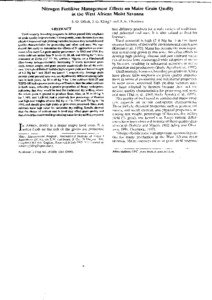| dc.description.abstract | Until recently, breeding programs in Africa placed little emphasis on grain quality improvement. Consequently, some farmers have not adopted improved high yielding varieties because they lacked desired quality characteristics for processing and other end uses. We conducted this study to determine the effects of N application on some maize (Zea mays L.) grain quality parameters. In 1993 and 1994, five maize cultivars under four N levels (0, 30, 60, and 120 kg ha- ') were evaluated at Zaria (11° U' N), northern Nigeria, on a Plinthustalf (fiue-Ioamy isohyperthermic). Increasing N levels increased ~rain yield, kernel weight, and grain protein quadratically for all the cultivars. The hybrid 8644-27 had the highest grain yield and kernel weight of 5,3 Mg ha- ' and 26.62 mg kernel-I, respectively. Average grain protein yield per unit area was not significantly different among cultivars in both years. At 30 to 60 kg N ha- ', the cultivars 8644-27 and TZPB-SR had a greater percentage of floaters, than the other cultivars in both years, reflecting a greater proportion of floury endosperm, indicating that they would be best for traditional dry milling, where the whole grain is ground to produce nour. Also, at 30 to 60 kg N ha- I , SPL and TZ8-SR had a relatively low percentage of floaters and high test weights of over 811 kg m' in 1993 and 778 kg m' in 1994, and should give high yields of grits when processed. Thus, both cultivars have high value for industrial dry milling. Results showed that the choice of cultivar and N level may affect grain quality and they should be considered in producing maize for dry milling purposes. |

